| |
Mural #1
In 1912, The Old National Trails Highway originally followed earlier Indian trails, pre-existing railroad tracks, and in some cases, newer road construction. In 1926, portions of the road were designated as the new US Highway 66. In the thirties, Barstow’s businesses moved from along the railroad tracks to the new highway to take advantage of the increased traffic. Route 66 became Barstow’s new Main Street. This is the 1st mural painted for this project and was completed in 1998. Principal artist was Jim Savoy, art instructor at Barstow Community College. Since then, many local artists have contributed to additional murals on Main Street.
Location: 513 E. Main Street ( Fraternal Order of Eagles)

Mural #2
“Camels” was the 2nd mural to be painted as a part of Barstow’s Main Street Murals project. It depicts the mission of General Edward Beale to survey a road from New Mexico to California. Part of his commission was to employ camels, to see if they could be used to carry freight to and from the Southwest. This proved not to be popular with the other drivers or mules and was eventually discontinued. The railroad and later Route 66 followed Beale’s route. This mural was the combined effort of artists Kevin Varty, Jim Savoy, and Kathy Fierro and was completed in 2000.
Location: 200 N. 2nd Ave (Clemmer Services)

Mural #3
The Three Million Dollar Harvey House mural was the 3rd in the Main Street Murals series and was painted in 2003 by Kathy Fierro. The image on the front of this card shows the “Casa del Desierto” train depot built in 1911. It was part of Fred Harvey’s famous Harvey Houses that were built along the Santa Fe Rail lines approximately every 100 miles. It was known for good food and clean accommodations. The picture of two “Harvey Girls represents the many young ladies that waited on customers during its heyday. The Harvey House was purchased from the BNSF Railroad by Barstow in 1990 and was subsequently renovated. Today it houses several businesses, two museums, and is available for banquets, meetings and parties.
Location: 423 E. Main Street (Bridges Academy of Beauty)
BACK TO TOP

Mural #4
Waterman Junction Becomes Barstow-1886 was painted in 2004 and was the 4th mural to be completed. It shows Barstow’s namesake, William Barstow Strong, and images which represent mining and the railroad. When the original Waterman Junction got a post office in 1886, it had to relinquish the name “Waterman” because there was already a town by that name on the postal route. So the community was renamed Barstow in Strong’s honor because he was the current executor of the Atchison, Topeka, & Santa Fe Railroa , the major employer in town.
This was the first of the Mural-in a-Day project. It was designed and outlined by master artist Kathy Fierro and actually painted in one day with the help of 40 volunteers of all ages.
Location: 401 E. Main St. (Realty One)

Mural #5
The Southern Route of the Mormon Trail, the 5th of the Main Street Murals, was completed in 2005. It was also the 2nd of Barstow’s “Mural in a Day” project. Many Barstow residents participated in filling in the colors and details designed by master artist Kathy Fierro.
This long mural is an historic and artistic rendering of several early routes through the Mojave Desert. In 1847, Mormon Soldiers who had served in the Spanish American War were honorably discharged in Los Angeles, California. The “Southern Mormon Trail” was the route they helped blaze to return to Utah from California. Later, it was used during the gold rush by hopeful miners and by Mormon families intending to settle in Southern California.
Location: 201 B 1st Ave (Desert Manna)
Mural #6
“The Early Explorers”, the 6th of Barstow’s Main Street Murals, was completed in 2005. It is divided into six individual portraits of men involved in the pioneering and settling of our part of the Mojave Desert. They are installed separately on the front of the Mercado Mall complex on the south side of Main Street. The portraits were painted by master artist, Kathy Fierro and include an explanation of each man’s contribution. They represent nearly 80 years of exploration from Father Garces’ native-led trek across Southern California in 1776 to Amiel Whipple’s hunt for a possible route for a trans-continental railroad in 1854.
Location: 222 East Main Street (Mercado Mall front)
 |
Father Garces 1738 – 1781
In early 1776, he set out northward from Yuma villages on the Colorado River on a journey that took him across the Mojave Desert to the Mission San Gabriel. He was the master of finding guides who would escort him through their own lands.
|
 |
Jedidiah Smith 1798 – 1831
In 1826 he led a party of 17 men through the territory of the Mojave Indians, then across our Great Desert. During the trek, the heat became so intense that it forced him and his men to bury themselves in the sand to keep cool. They were the first Americans to enter Califonia overland from the east.
|
 |
John C Fremont 1813 – 1890
Called “Path finder”, he was known as the West’s greatest adventurer, noted for bravery and his meticulous recorded notes on vegetation and geography. ON his 3rd expedition across CA in 1845 he, along with Kit Carson, led the California Pioneers to rebel against Mexico to gain Independence.
|
 |
Christopher Houston “Kit Carson” 1809 – 1868
Kit Carson was born the 9th of 14 children on Christmas Eve, 1809 in Madison County, Kentucky. During his long and illustrious career ranging throughout the Desert Southwest, he was a trapper guide, military scout, Indian agent, soldier, rancher and authentic legend. Carson’s service guiding Fremont across the deserts and mountains of the American West… documented in Fremont’s widely read reports of his expeditions…made Kit Carson a national hero.
|
 |
General Steven Watts Kearney 1794 – 1848
He was “the Father of the US Cavalry” and President Plk named him “Commander of the Army of the West”. In 1846 he went from Sabta FE, NM on to CA with 100 men on an arduous trip across our desert and on to a battle at San Pascal in the fight for Independence from Mexico.
|
 |
Amiel Weeks Whipple 1817 - 1868
His expedition for a transcontinental railroad, crossed the Colorado River on February 27th 1854 and three weeks later reached Los Angeles, receiving aid from Mojave Indians. The Atcheson, Topeka and Santa Fe Railroad followed Whipple’s trail for much of the way from Albuquerque to California. The scientific reports are considered a ‘Glorious Chapter” in the history of American science.
|
BACK TO TOP

Mural #7
The California Gold Rush was the 7th of the Main Street Murals completed and was also the 3rd of the “Mural in a Day” projects. The discovery of Gold in Central California in 1848 and subsequent statehood saw floods of people wanting to head west. As the western population grew, the government began looking for ways to build a railroad to the region. A railroad would make travel easier, would help develop commerce, as well as move troops to areas that would otherwise be hard to defend. Master artist Kathy Fierro created this mural in 2006 to demonstrate the impact that California’s gold rush, Barstow area’s mining and the development of the railroad had on our local history. Many Barstow area residents helped to paint this mural in just one day.
Location: 212 E. Main St.

Mural #8
This year Main Street Murals developed an educational program based on The Old Spanish Trail of 1829 – 1848. This was a four month project involving school children and key historical, cultural and artistic groups from the community.
The program culminated in a Community-wide Mural-in-a-Day on April 28, 2007. Artists will continue to finish the mural in the coming weeks in time for a presentation to the Annual conference of The Old Spanish Trail Association held in Barstow, June 7-9, 2007. The mural was dedicated as part of the conference on Saturday, June 9th.
The Master Artist is David Brockhurst, with a team led by: Candice Michelson, Kathy Fierro and Jane Laraman-Brockhurst.
The Community Mural painting started at 8am with presentations and entertainment from the Old Spanish Trail Association, BLM and live music throughout the day. Also in attendance was KDUC radio with a live broadcast from the mural painting site.

Mural #9
NATIVE AMERICAN VOICES OF THE MOJAVE DESERT
Native American Voices from the Mojave Desert was the 9th of the Main Street Murals and was completed in 2008. This large mural was the collaboration of David Brockhurst, Alyssa Schwaltz, Bill Smith, Jane Laramar Brockhurst and several high school students. .
Ancient Indians are thought to have emigrated to the desert after the last ice age approximately 11,000 years ago. The Anasazi were the earliest tribes to occupy the wide expanse of the Mojave Desert. They were followed by the Chemehuevi, Cahuilla, Beneme, Paiute, Serrano and Kawaiisu. Most lived along the Mojave River. The Vanume lived in the Barstow area. They were hunters and gatherers, using all parts of the Mesquite tree for food, clothing and shelter and hunting any animals found. The Mohaves occupied lands closer to the Colorado River and were a much more warlike tribe. They are mentioned in journals from the late 1700’s kept by Father Garces, an early southwest explorer.
Location:410 E. Main St.

Mural #10
CITY OF BARSTOW
The City of Barstow mural was painted by an art class at Barstow High School before the Main Street Murals project was developed. It is a fine mural however and has been adopted into the Main Street Murals walking tour. It represents major elements that have impacted this city for over 100 years. The National Training Center at Ft. Irwin, NASA’s Goldstone Deep Space Tracking facility, the Marine Corps Logistic Base, and Santa Fe Railroad (now BNSF) have been the economic lifeline of the Barstow community. The nearby mining town of Calico is now a ghost town that attracts thousands of visitors each year. The Route 66 Museum and the Western American Rail Museum in the 100 year-old “Harvey House” interests tourists as well. The picturesque Joshua Tree and flowering yucca are native to the Mojave Desert. Barstow’s Main Street is a remnant of the historic “Route 66”.
Location: 113 E. Main St. (East Wall)

Mural #11
THE MOJAVE RUNNERS
The “Mojave Runners” were the native version of the pony express. These were runners of the Mohave tribe whose lands were near the Colorado River. In 1844, John C. Fremont, and Kit Carson were exploring a trail used by the Mohaves. They met 6 Mohave runners who sometimes ran up to 100 miles a day to carry information and messages to distant villages. They said that they had once lived in that area raising vegetables. Fremont is credited with naming the Mojave Desert and River because of this interaction. This smaller mural was the 11th in the Main Street Murals series. It was researched and designed by master artists Juliette Tison and Kathy Fierro.

Mural #12
TWENTY MULE TEAM
In 1912, The Old National Trails Highway originally followed earlier Indian trails, pre-existing railroad tracks, and in some cases, newer road construction. In 1926, portions of the road were designated as the new US Highway 66. In the thirties, Barstow’s businesses moved from along the railroad tracks to the new highway to take advantage of the increased traffic. Route 66 became Barstow’s new Main Street. This is the 1st mural painted for this project and was completed in 1998. Principal artist was Jim Savoy, art instructor at Barstow Community College. Since then, many local artists have contributed to additional murals on Main Street.
Location: 513 E. Main Street ( Fraternal Order of Eagles)

Mural #13
THE BEACON HOTEL
In 1912, The Old National Trails Highway originally followed earlier Indian trails, pre-existing railroad tracks, and in some cases, newer road construction. In 1926, portions of the road were designated as the new US Highway 66. In the thirties, Barstow’s businesses moved from along the railroad tracks to the new highway to take advantage of the increased traffic. Route 66 became Barstow’s new Main Street. This is the 1st mural painted for this project and was completed in 1998. Principal artist was Jim Savoy, art instructor at Barstow Community College. Since then, many local artists have contributed to additional murals on Main Street.
Location: 513 E. Main Street ( Fraternal Order of Eagles)

Mural #14
THE ICE AGE
The Ice Age was the 14th mural created as a part of the Main Street Murals project. The master muralist was David Brockhurst. This mural depicts how the Mojave Desert may have looked in pre-historic times. It shows a time when this area had lakes, rivers and lush green grassy areas which supported many plants and animals. As the glaciers melted, the land dried. Many of the animals and plants were not able to survive the changes that took place. Those species that did gradually adapt are those that are able to live successfully in our arid desert today.
Location: 404 E. Main St. (Teplow Drug, parking lot behind store)
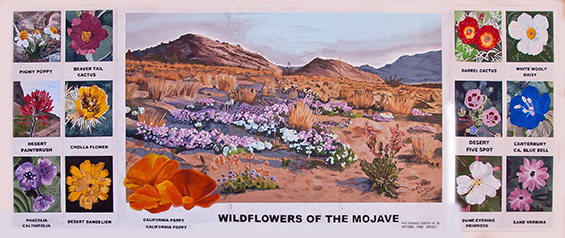
Mural #15
WILD FLOWERS OF THE MOJAVE
Wildflowers of the Mojave Was the 15th mural created as a part of the Main Street Murals project. The master artist was Kathy Fierro. Depending on the previous winter’s rainfall, wildflower seeds that have been dormant since the heat of the previous summer will germinate and fill the desert with color. Sometimes the bloom is moderate; sometimes it is very scarce; but some years it is spectacular. The flowers pictured on this mural are typical of what can be seen in parts of the desert in the spring.
Death Valley, Anza Borrego State Park, Joshua Tree National Park, Lancaster Poppy fields and various area canyons often treat the visitor to beautiful carpets of flowers in March and April.
Location: 616 E. Main St.

Mural #16
SILVER MINING IN THE MOJAVE
April 6, 1881, S.C. Wardan, Hues Thomas and John C. King located claims on Calico Mountain and named it the Silver King Mine.
Below there, the town of Calico grew from 100 people in the spring 1882 to over 1,200.
There were no less than 46 mines near Calico, like the Waterloo, Bismarck, Oriental, Garfield and Burning Moscow.
The falling price of silver shut down the mines by 1896. They had produced between $13,000,000 and $20,000,000 worth of silver.
Calico, burned to the ground in the fall of 1883 and was rebuilt, but was vacated in the 1930s.
It remained derelict until 1950 when Walter Knott converted the ghost town into a tourist attraction.
In 1883 by Postmaster Jim Stacy found Dorsey, the "mail carrying dog.”
Soon, the dog was carrying all the mail from Calico to Bismarck, in little pouches strapped to his back.
Stacy was offered $500 for the dog, to which Stacy replied: "I'd rather sell a grandson."
Dorsey later became famous in legend, book and movie.

Mural #17
ANIMALS OF THE MOJAVE
Animals of the Mojave are well -adapted to arid conditions. Travelers often report spotting coyotes, jackrabbits, or lizards in the desert around the Barstow area. Where protective “tortoise fences” have not been installed, desert tortoises are sometimes seen along the roadways and the red-tailed hawk can be a common visitor to many back yards. Encountering other desert animals is more unusual but they are here. You may have to hike the mountains or explore where water seeps above ground to see any evidence of them. (Word of caution: Where poisonous snakes are concerned, in the summer avoid bushes, very soft sand, and don’t lay your hand where you cannot see!) The image on this card is of the 17th mural created as a part of Barstow’s Main Street Murals project. The master artist was Kathy Fierro.
Location: 100 Main St. (Starlight Donuts)

Mural #18
RAINBOW BASIN
Rainbow Basin is a geological marvel located 8 miles northwest of Barstow just off Fort Irwin Road. It is a series of “gashes“ in the arid Mojave Desert terrain that reveals multicolored layers from thousands of years of uplifting and erosion: a snapshot of the prehistoric evidence that nature continually rearranges and recreates. The loop road unpaved but well graded and does not require a
4-wheel vehicle for exploration. On the website, Desert USA.com, Len Wilcox wrote” It’s (Rainbow Basin) a mish-mash of shapes, colors and fantastic formations.”
It was painted by Nicole Vargas-Santiago and Kathy Fierro in 2013 and was the 18th
mural completed in the Main Street Murals series.
Location: 703 E. Main Street (Desert Sanctuary)

Mural #19
OWL CANYON
Owl Canyon is in Rainbow Basin Natural area 8 miles northwest of Barstow. It is a series of small desert canyons, hills, and washes. There are interesting trails, amazing desert scenery and even a few small caves to explore. Like the adjacent Rainbow Basin, the colors of the hills change with the light which makes photography a pleasure.
A campground managed by BLM has been developed there. The road to the campground is bumpy but manageable. There are no hook-ups but each site has a picnic table, paved patio and shade. The desert here is very dry and it is easy to get dehydrated. Some water is available but it is always best to bring plenty of water along when you go. On the plus side, the restrooms are clean and the star gazing at Owl Canyon is incredible. This mural was the 19th of the Main Street Murals project and was painted by Nicole Vargas-Santiago.
Location: 703 E. Main St. (Desert Sanctuary)

Mural #20
THE WILDERNESS
The Wilderness was the 20th mural created as a part of this project. The master artists were Kathy Fierro and Nicole Vargas-Santiago. This mural shows some of the natural treasures located throughout the wilderness areas of our local desert. It depicts places such as Soda Dry Lake, petroglyphs and Rodman Mountains. You get a flavor of the desert when you read the words the artists have painted by the pictures: “untrammeled,” “primitive”, “natural”, “solitude”, and “undeveloped”. These are reminders that the desert is fragile and we need to protect it for future generations.
Location: 708 E. Main St. (Swiss Dairy Liquor)
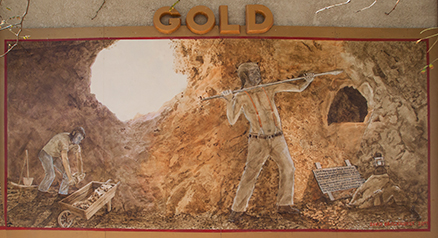
Mural #21
MINING THE MOJAVE: GOLD
Gold was the 2nd mural of the “Mining in the Mojave” series. It was the 21st of the Murals to be installed on Main Street. David Brockhurst was the master muralist.
Hopeful miners flocked to California after the discovery of Gold at Sutter’s Mill in 1849. ”. After 1849, new prospectors scoured the Mojave Desert hills for signs of possible gold deposits. It was very hard work that only sometimes paid off.
In 1895, gold was discovered at Randsburg about 80 miles north of Barstow. It was one of the richest gold mining areas during the 20th century. In 1898, a 50-stamp mill was temporarily built in Barstow to handle the ore processing from Randsburg but was supplanted one year later by other stamp mills built closer to the mines. The last Randsburg mine finally closed about 2010. Today, there are nearly 40 open gold mine claims on file in the Barstow-Yermo-Daggett area. Gold fever and hope still seem to go hand in hand.
Location: 239 E. Main St. (Union Bank)
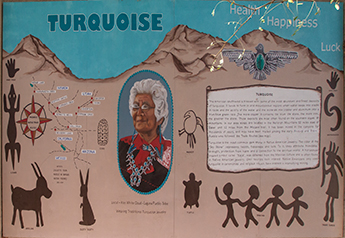
Mural #22
MINING THE MOJAVE: TURQUOISE
The Turquoise mural was painted by Juliette Tison and Melissa Fierro in 2014. It is the 3rd in the “Mining in the Mojave” series and is the 22nd mural to be installed as a part of the Murals on Mainstreet
Project. It features Kay Whitecloud of the Laguna Pueblo, a long-time resident of Barstow and Native American Activist here.
Turquoise is a mixture of copper and aluminum and considered to be a gemstone. It has been found abundantly in the southwest. Historians think it may have been traded among the very early Anasazi natives. Turquoise is often paired with silver for jewelry or other decorative items. Traditionally, the use of this stone represented health, happiness and life.
Location: 239 E. Main St. (Union Bank)

Mural #23
MINING THE MOJAVE: Natural Colored Rock
As a part of the Main Street Murals project, four separate murals were created to celebrate the impact that Mining in the Mojave has had on the Barstow area. The fourth of these was Natural Colored Rock by master artist Juliette Tison.
After WW II, colored rock was popular as a roof covering. Brubaker-Mann Natural Colored Crushed Rock opened in Barstow in 1950 predominantly as a roofing materials business. They shipped colored rock all over the country and their business grew. Over the years in order to obtain the different colors that they sold, they filed many mining claims.
Today, due to years of drought, many desert families and retail businesses have opted to replace lawns with yard designs done in natural colored rock. Although other colored rock businesses have developed in the area, Brubaker-Mann is still locally owned, and is still very successful.
Location: 239 E. Main St. (Union Bank)
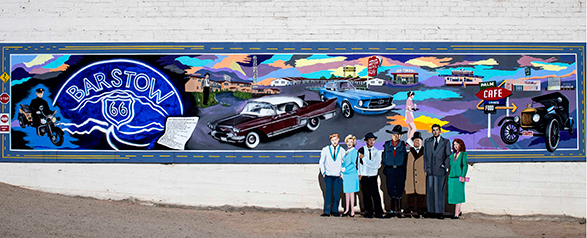
Mural #24
BARSTOW 66 - CELEBRITIES
This is the 24th mural created as a part of the Main Street Murals project. It was designed by master muralist David Brockhurst in 2015-2016.
This mural shows some of the iconic businesses that have thrived at different times in Barstow. This is unique among the murals as it depicts some of the celebrities that stayed in Barstow on a regular basis. The artist has placed free-standing cut-outs of these personalities in front of the mural for visitors’ photo opps.
Location: 613 E. Main St. (Barstow Garden Supply)

Mural #25
ROUTE 66 DREAMERS (BURMA SHAVE)
Master artists Juliette Tison, Kathy Fierro, and David Brockhurst were assisted by many community volunteers in the creation of the Greetings from Main St. Murals- Route 66. It was installed and dedicated in October, 2016 in preparation for Barstow’s celebration of the 100th anniversary of the establishment of Route 66 as a part of the U.S. Highway system. Main Street Murals first president writes: “We thank you for being part of our Route 66 dream and hope you’ll share what you’ve found here.” This was the 25th mural to be completed.
Location: 108 A 1st Ave

Mural #26
NEWBERRY CAVE
Treasure of the Mojave Desert
This ancient site, excavated in the 1950s, overlooking the remains of Pleistocene (Ice Age) Lake Manix contained 11,000-year-old Ice Age bones of extinct animals, such as the ground sloth and dire wolf.
But human artifacts found in Newberry Cave were so impressive that some archaeloogists have called the years from 4,000 to 3,000 years ago the “Newberry Period.” Found here were what might be a male-magical, hunting ritual site. Human artifacts found were the atlatl, a spear or dart throwing stick, along with atlatl darts and points—used in the Mojave Desert before bows and arrows, mountain sheep dung pendants, and especially3,500-year-old split-twig figurines of animals. On the cave walls were rare white, black, red and green pictograph (wall paintings).
Because of these artifacts, we now have the “Newberry Period.”
BACK TO TOP
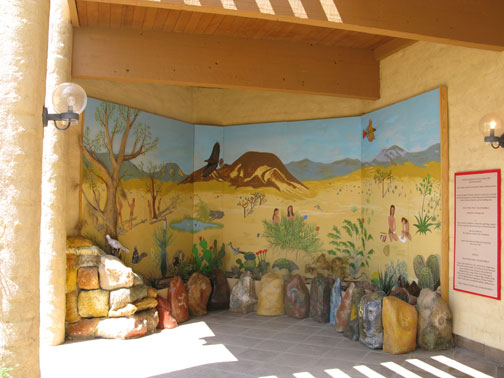
Desert Discovery Center

The town of YERMO, has been known for years as the "Gateway to the Calico Mountains."
In 1830, Antonio Armijo wrote about stopping in the area at an Indian village for water whilst travelling on the Old Spanish Trail, later pioneer Americans passed through on the Mormon Trail from Salt Lake to Los Angeles.
In the late 1880’s silver and copper mining towns of Calico and Marion sprang up and later died away after mines in the Calico Mountains were worked out.
The original name for the town was Otis. By 1904 the town was established as a material yard for the railroad. In 1905 the company completed the Roundhouse and Depot, which later became the Union Pacific Railroad.
In 1907 the town applied for a post office and found another town in Colorado had the same name, so Townspeople elected to change the name to YERMO, Spanish for "Desert".
In 1929 an Agricultural inspection Station was opened on highway 91. This became the main road through town & more than 1.5 million visitors a year traveled through this gateway into Southern California.
In 1942 the US Navy opened a supply center. The base is still in operation today as a major US Marine corps Logistics, Supply and Rebuild facility.
In 1975 the new interstate 15 freeway was completed and almost immediately the town lost its through town traffic.
The town of Yermo is still an active community with 2000 residents, many of whom work at the Marine Base, Railroad or commute out of the area.
Sponsored by Yermo CSD
BACK TO TOP
|
|

